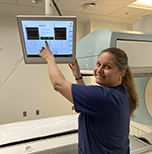
What interested you in becoming a nuclear medicine technologist?
Math and science have been an interest of mine since grade school. In my junior and senior years of high school, I had my college prep focus narrowed down to nuclear medicine and medical technology, where both can be achieved with a two-year degree.
What physical and/or soft skills do you need to have to succeed?
You need to have good communication skills to be able to answer questions asked by both co-workers and patients. You must also be able to aid patients with the anatomical positioning for the desired exams, getting on and off the table, and in and out of their wheelchairs or beds.
What advice would you give to interested students?
Patient healthcare can be difficult for some, and students need to be aware of possible future challenges. Patients can have different ways of handling their emotions when undergoing procedures and testing, all of which you cannot take personally. I treat every patient like I would treat my family.
What interested you in working at Cleveland Clinic?
I have been in nuclear medicine for 22 years. I have had many experiences and embarked on specialties. After many years working for a small community hospital and then a mobile PET company, I was awestruck when I arrived at Main campus for my interview. I knew then Cleveland Clinic would supply me with the most when it came to advancements and research in my field.
What excites you about working as a nuclear medicine technologist?
All imaging modalities are intriguing, but nuclear medicine sets itself apart by using the human body's physiology. We can look at the body on a cellular functioning level. Nuclear medicine can show infections, cancers, cardiac viability, and so much more!
What has been your most gratifying experience as a nuclear medicine technologist?
The telltale sign of a gratifying experience is the patient's expression of thanks once a procedure is complete. It sometimes comes in the form of a thank you card, or cookies sent to the department. My favorite is the simple smile and the kind exchange of words the patient and I share after the procedure.
How has the career field changed since you started? What does the future look like?
PET (position emission tomography) has changed a lot in the last five years. New radiopharmaceuticals have been developed that are more tumor and cell type specific. The production of new radiopharmaceuticals has made neuroendocrine cancers easier to diagnose, stage, and treat. Other radiopharmaceuticals have been created to show metastatic prostate cancer in its earliest stages for patients with the slightest elevated PSA levels. The advancements have led the way to theragnostic, a radioactive therapy that treats diseases utilizing the cellular pathway of specific tumors.
I would say the future of nuclear medicine looks bright!
Learn More
- Nuclear medicine technology programs affiliated with Cleveland Clinic.
- Visit the nuclear medicine technologist profile for more about this career path.
- Read our nuclear medicine technology brochure.